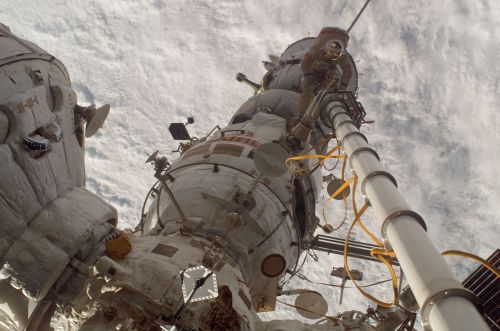

In the quiet that follows the ISS’s final crew departure, the absence will be felt by a public accustomed to the idea that somewhere above them, an American-led crew was always looking down.

By Matthew A. McIntosh
Public Historian
Brewminate
Shifting from Permanence to Presence
For decades, NASA’s language about low Earth orbit was marked by a confident permanence. The International Space Station was not only a platform for science and technology but a geopolitical flag planted in the sky. U.S. officials promised there would be no gap between the ISS and whatever came next. Now, the agency’s latest policy revision suggests a subtle but unmistakable retreat from that vision.
Earlier this month, Acting Administrator Sean Duffy issued a new directive for the development of commercial space stations. Gone was the requirement that any successor maintain a continuous human presence in orbit. In its place was a looser standard: the capacity to host four crew members for up to a month. For advocates of uninterrupted operations, this is not a mere procedural tweak. It represents a fundamental rethinking of the United States’ orbital ambitions.
The End of an Era?
The ISS has been occupied continuously since November 2000. That record has become a point of national pride and international influence. NASA’s decision to loosen its requirements for the next generation of stations is a recognition of hard realities.
Commercial partners such as Voyager Space, Blue Origin, and Axiom Space are building ambitious concepts for private orbital platforms. But their timelines are tight, their engineering challenges significant, and their business models unproven. The new standards effectively reduce the bar, allowing smaller, less expensive stations to qualify for NASA support. It is a decision that favors flexibility and the hope of meeting deadlines over the prestige of uninterrupted crewed missions.
Political and Financial Gravity

The policy change comes as Congress debates NASA’s funding levels for low Earth orbit operations beyond the ISS. Cost pressures are mounting, not only from within NASA’s own budget but from other national priorities. Artemis, the agency’s lunar program, commands billions each year, and the coming push toward Mars will demand even more.
Maintaining a large-scale, permanently staffed station in orbit is expensive. Between transportation, life-support, maintenance, and crew rotations, the ISS costs the United States roughly $3 billion annually. A more limited presence could save money and free up resources for exploration beyond Earth’s orbit. Critics, however, argue that the savings will come at the expense of American leadership in space.
Strategic Risks in the Gap
If the ISS is retired around 2030, as currently planned, and its successors do not provide continuous habitation, the United States will cede a unique and symbolic capability. The gap could allow rivals, most notably China, to claim the mantle of uninterrupted human spaceflight leadership. Beijing’s Tiangong station has been fully operational since 2022, with crews rotating regularly.
NASA officials have framed the shift as a calculated risk. A shorter-term, rotating presence, they say, is better than promising a permanence the agency and its partners might not be able to deliver. Yet, for those who remember the nine-year gap between the retirement of the Space Shuttle and the first crewed SpaceX launch, the risk of losing ground feels all too real.
A Future in Flux
Supporters of the new approach argue that it embraces the commercial reality of the coming decade. Not all station developers will be ready to operate around the clock, and some might never intend to. By setting a more achievable threshold, NASA hopes to foster competition and innovation. Smaller stations could serve niche markets, from microgravity manufacturing to space tourism, while NASA buys crew time as needed for research and training.
The agency’s pivot is, in part, a bet on diversity of platforms rather than on a single flagship station. That vision is pragmatic, but it is also fragmented. Without a central hub akin to the ISS, the narrative of U.S. leadership in low Earth orbit becomes harder to sustain. What was once a singular, global symbol risks becoming a patchwork of smaller, transient footholds.
The Long Game
NASA’s leaders insist that the United States will remain a constant presence in space, even if not in the form many expected. Yet the very definition of presence is now in question. A permanent outpost is a statement of intent; a rotating presence is a statement of capability. The difference is subtle in language but stark in meaning.
The revised policy leaves the future of human spaceflight in low Earth orbit more open than it has been in decades. It may be a necessary concession to budgets, timelines, and engineering realities. It may also be the first step toward an era in which American astronauts no longer call any single orbiting platform home. In the quiet that follows the ISS’s final crew departure, the absence will be felt not just by engineers and astronauts, but by a public accustomed to the idea that somewhere above them, an American-led crew was always looking down. That absence will not be easily filled.
Originally published by Brewminate, 08.13.2025, under the terms of a Creative Commons Attribution-NonCommercial-NoDerivatives 4.0 International license.


